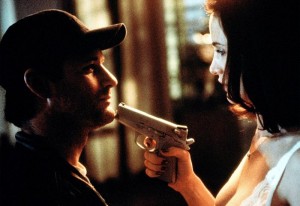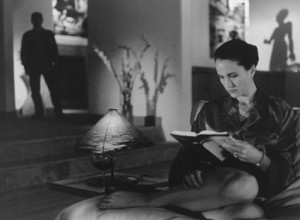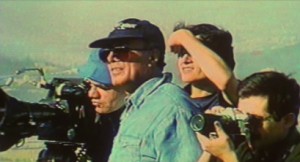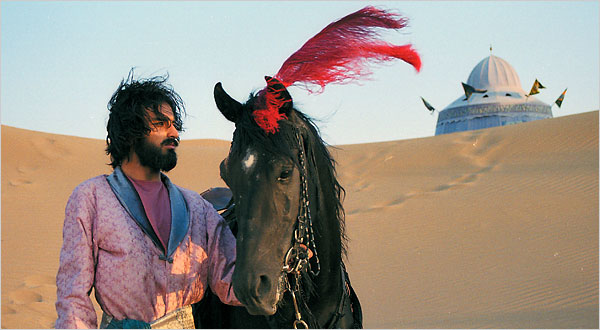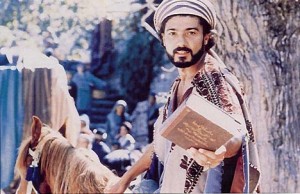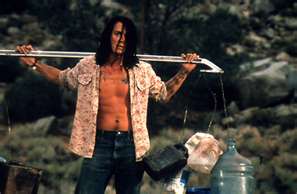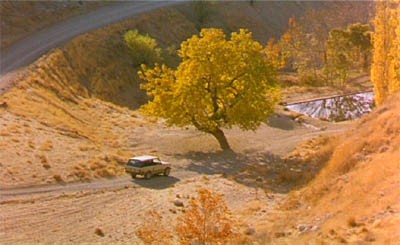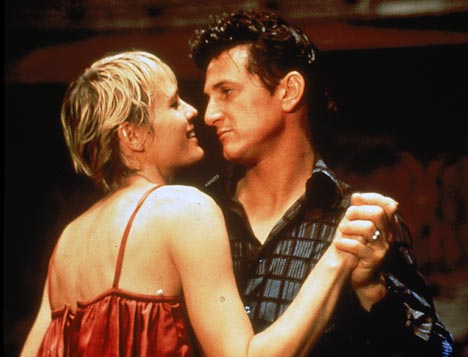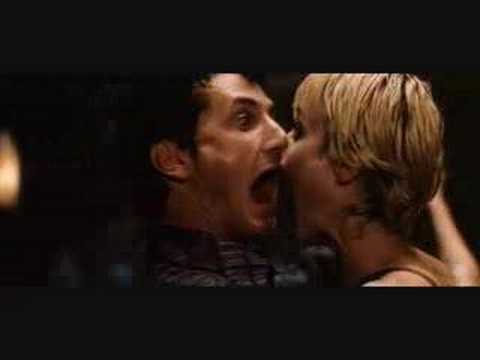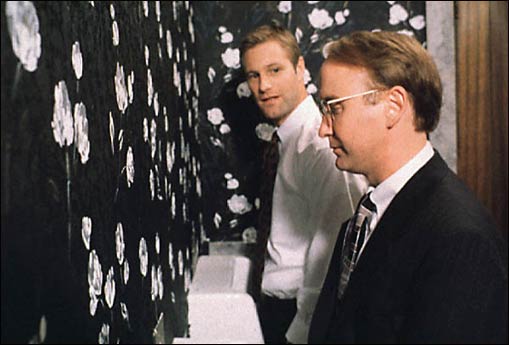Adapted from “Cannes, tour de Babel critique,” translated by Jean-Luc Mengus, in Trafic no. 23, automne 1997. –- J.R.
By common agreement, the fiftieth anniversary of the Cannes
Film Festival, prefigured as a cause for celebration, wound up serving
more often as an occasion for complaint. Disappointment in the over-
all quality of the films ran high, even if the arrival over the last four days
of films by Abbas Kiarostami, Atom Egoyan, Youssef Chahine, and
Wong Kar-wai improved the climate somewhat. But I don’t mean to
suggest that the shared feelings of anger and frustration demonstrated
any critical unanimity. On the contrary, the overall malaise of Cannes this
year forced to a state of crisis the general critical disagreement and lack
of communication that has turned up repeatedly, in a variety of forms.
If the pressing question after every screening at Cannes is whether a film
is good or bad (or, more often, given the climate of hyperbole,
wonderful or terrible) — a question that becomes much too pressing, because
it short-circuits the opportunity and even the desire to reflect on a film for
a day or week before reaching any final verdict about it — the widespread
disagreements at the festival derived not only from different and
irreconcilable definitions of “good” and “bad,” but also from different and
irreconcilable definitions of “film.” And the ensuing Tower of Babel
brought into sharp relief the competing agendas — in some cases
implicit, in come cases explicit — of such an occasion.
One film that I like, for instance, unlike most of my colleagues, is
Wim Wenders’s The End of Violence, yet the very terms of my
approval — that Wenders has finally succeeded in making an
entertaining Hollywood film — is so much at odds with the terms of
the other critics and programmers I speak with, who find the film
neither entertaining nor Hollywood, and who find it “heavy” to the same
degree that I find it “light,” that we might as well be speaking different
languages. Fifteen years ago, at the Toronto Film Festival, I experienced
a similar sense of isolation after seeing and liking Wenders’s Hammett.
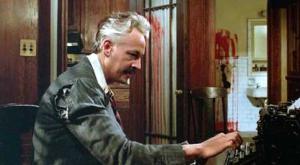
My conclusion then was that Wenders had belatedly fulfilled one of the
central dreams of the French New Wave and its offspring (such as Bertolucci’s
project to adapt Red Harvest) — to make a European cinéphile feature
employing all the resources of a Hollywood studio. But in 1980, at least,
I still had the New Wave Hollywood as a reference point to employ.
Today the only terms I can draw upon to describe The End of Violence
are “Hollywood” and “art film,” and both terms, I discover, are no longer
categories that refer to shared realities to the same extent; more
precisely, they’re the ghosts of categories that continue to be used only
because others haven’t yet been found to replace them. So maybe one
reason why what I find light, entertaining, and thoughtful others find
heavy, boring, and preachy is that we’re calling on different contexts and
instruments of measurement. I’m thinking of all the recent stupid
American commercial films that bore and offend me, which makes The
End of Violence look good, but others are thinking of Wenders’s
previous nineties films, which they (and I, for that matter) regard as relatively
boring and forced, and see the film as part of the same negative pattern.
Even the usual way of identifying festival films, such as title, director,
and country of origin, is sometimes inadequate or misleading.
Kiarostami’s Taste of Cherry, by all counts my favorite film at the
festival, regarded by most people as purely Iranian, makes prominent
use of Kurdish, Afghan, and Turkish characters, and ends with a recording
of “St. James Infirmary” by Louis Armstrong. When asked in his press
conference about why he used a “jazzy” trumpet at the end, Kiarostami
spoke of neither the relevant images of death contained in the lyrics of
“St. James Infirmary” nor of Armstrong, but of his conviction that music
belonged to everyone in the world, adding that the trumpet evoked the
soldiers in training that are seen in the final sequence. The fact that this
final sequence was shot in video was even more troubling to some
viewers than the jazz trumpet, but surely both the music and the video
constitute a kind of lingua franca within both Iran and the cinema as a
whole — suggesting that in an era when multicorporations may be more
pertinent as defining entities than countries, the usual definitions of
nationality have to be reformulated, reimagined, rethought. Like the
outworn categories of film criticism, much of the current nationalistic
discourse refers to the past, not to the present or the future. This isn’t to
say that certain references to the past don’t continue to be useful.
Yousef Chahine’s Destiny is a French-Egyptian grand spectacle and
musical that recounts the life of the Andalusian philosopher Averroes.
But I suspect that the most important reference point shared by
Chahine and myself is actually a style of Hollywood studio filmmaking
of the fifties, so that I’m reminded at various moments of films as good
as The Adventures of Hadji Baba and as mediocre as Kismet — a house
style that I associate mainly with M-G-M and only secondarily with
various directors (e.g., Anthony Mann, Richard Thorpe, Don Weis,
Vincente Minnelli, George Sidney, Mervyn LeRoy). By the same token,
even though Chahine, as evidenced by his retrospective in Locarno last
year, is fully recognizable as an auteur, this doesn’t necessarily mean
that the aspects of Destiny that are or should be most interesting to me
are its personal traits. I’m more inclined to be fascinated by the route of
a Westerner (myself) into the mysteries of Arabian and Egyptian cinema
charted over distant memories of Hollywood films made over forty years
ago, a process in which Chahine serves as one of many possible
emissaries rather than as any particular destination. But old critical reflexes
die hard, and a surprising number of films at Cannes encounter certain
kinds of critical resistance precisely because the auteurist grid of
director, camera, and mise en scène doesn’t yield the proper results.
One case in point is the charming and lively French Canadian
feature Cosmos shown in the Fortnight, a collection of slightly
interconnected comic sketches filmed in Quebec City in black-and-white by six
young writer-directors, one of them the cinematographer of the entire
feature. The narrative form in which two or several stories equals one
story — represented in twentieth-century literature by such works as
Faulkner’s The Wild Palms, Anderson’s Winesburg, Ohio, and Joyce’s
Dubliners — has many interesting examples in cinema ranging from
Intolerance to Out 1, from The Little Theater of Jean Renoir to
Kieslowski’s Red, and from Vera Chytilova’s About Something Else to Errol
Morris’s Fast, Cheap, and Out of Control. Though less significant than
these films, Cosmos still poses interesting methodological problems by
having multiple authorship as well as multiple stories. The
conventional critical approach to such a feature is to evaluate the style and
mise en scène of each episode separately, but to do that in this case is
nonfunctional because what these sketches have in common — a
certain New Wave flavor — is much more important than what
distinguishes them from one another. (This was also true of some of
the early New Wave features when they first appeared, before they became
recatalogued along auteurist lines.) Some of the episodes overlap via i
ntercutting, and clearly the feature as a whole was conceived and to some
extent executed collectively.
A related critical conundrum was posed by the 1995 U.S. release of
the 1964 Soviet documentary I Am Cuba — a film that is commonly
credited to its director (Mikhail Kalatozov) rather than to its
cinematographer (Sergei Urusevsky) or its cowriter (Yevgeny Yevtushenko)
when its eccentric style can’t really be read as the expression of a single
consciousness. When, in a famous early extended take, the camera on
a rooftop overlooking the Havana beaches moves several stories down to
tourists around a swimming pool, then follows one woman in a dress
only to abandon her in favor of a bathing beauty whom it then follows
into the swimming pool, even proceeding underwater with her, the
usual critical procedure is to identify Kalatozov with the camera and to
applaud his virtuoso mise en scène. But in fact, the shot was carried out
by a relay team of three separate camera operators — a good example of
collective work in action, communist filmmaking in the truest sense of
the word — and in the final analysis the model of a solitary artist
probably functions better here as a guide to reading the shot than as any
reliable indication of its mode of execution.
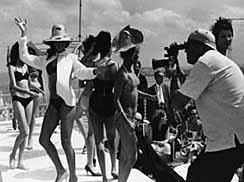
The problem, really, is that critics are still dealing with the residue
of a polemical position about mise en scène that was once necessary to
win certain battles, but which has regrettably eclipsed and obscured
other central creative areas — including even what the films are about.
Few critics took Orson Welles at his word when he insisted that he
always began with the written word, not with images, and indeed, the
writer-director-performer has perhaps suffered the most from the
critical emphasis on the latter two functions: how many critical studies have
bothered to consider the essential importance of Charlie Chaplin and
Erich von Stroheim as writers — inextricably tied to their work as actors,
which their mise en scène served largely to implement?
***
The most striking difference for me in overall atmosphere between
Cannes in the seventies and Cannes in the nineties can be seen in the
press conferences, which used to resemble gladiatorial combats and are
now almost completely predetermined publicity sessions, most of them
controlled by compulsive politeness and relatively useless when it comes
to the exchange of either ideas or information. Two characteristic
questions I can recall from the seventies are (1) after the screening of The
Mother and the Whore, addressed to Jean Eustache: “Why did you choose
to make a film instead of write a novel?” and (2) after the screening of One
Hamlet Less, addressed to Carmelo Bene, dressed in a white suit: “Do you
sleep at night in pajamas or in the nude?,” to which Bene replied, “Fuck
you.” Today, the most characteristic question is to ask a star what it was
like to work with a director (or vice versa), and no less characteristic are
the responses—testimonials about how wonderful he or she is.
What happened to alter this former climate of contestation, which
I find this year only at the press conference for Mathieu Kassovitz’s
Assassin(s)? The latter movie is as typical of current filmmaking trends
as the title of Michael Haneke’s Austrian film, Funny Games, the latter
functioning as both a commercial ruse and an ironic critique of a
commercial ruse — making Haneke’s film as divided against itself as
Assassin(s), a lowbrow exploration of the same general theme. Even
Kassovitz’s flagrant borrowings from Martin Scorsese’s Taxi Driver and
GoodFellas and Oliver Stone’s Natural Born Killers testify to the same
puritanical duplicity that is found in these sources: the simultaneous
desire to succeed commercially in the American manner while
criticizing this very manner is a form of hypocrisy already found in the
Scorsese and Stone films.
The desire to see some old-style Cannes squabbling is what drove
me to Kassovitz’s press conference, though alas, despite his cogent
efforts to challenge the lack of seriousness of the press, not very much
light was shed at this event — except, perhaps, for the hostility of the
press at Cannes toward any film that has an overt thesis of any kind.
(1999 postscript: Another casualty of this bias was Johnny Depp’s
muddled and naive but touching The Brave, a first feature starring Depp and
featuring Marlon Brando in a cameo — an allegory that recalled sixties
follies such as Dennis Hopper’s The Last Movie and was received so
poorly that, like Assassin(s), it has never opened in the United States.)
Clearly a lot has happened to information flow over the past twenty
years, at least within the public sector. First of all one should cite the
development of techniques designed to flatter and thereby control the
political press inaugurated in the United States by the Reagan
administration. Then came the adaptation of these same techniques by
Hollywood publicists, while at the same time the studios’ publicity
campaigns became more lavish, leading to the corrupt allegiances of
“entertainment news” in which publicists and journalists willingly join
forces against the interests of the public, leading to the mode of mutual
flattery that now predominates. Within the new system, any journalist
who asks a rude or skeptical or probing question risks losing access to
the publicists who control access to the “talent” (stars, directors,
writers, etc.) and alienating his or her own editor in the process.
The cosmetic surgery performed on news in these transactions
applies to nearly all the Cannes press conferences, not merely those for
expensive commercial films. Consider, for instance, the high drama
constructed around the alleged state banning of Kiarostami’s Taste of
Cherry because of its treatment of the theme of suicide. Certainly the
question of whether the Iranian government would allow the film to be
shown in Cannes was a genuine issue prior to the festival — not because
of its theme, as it turned out, but because of a bureaucratic technicality —
but the fact that this issue was settled before the festival began didn’t
stop Gilles Jacob from orchestrating its eventual arrival like a
breathless cliffhanger.
Furthermore, the self-righteousness of many critics and journalists in
denouncing state censorship — generally more relevant to the career of
Mohsen Makhmalbaf than to that of Kiarostami — doesn’t prevent them
from ignoring (and thus tolerating and helping to protect, therefore
supporting) the numerous instances of capitalist censorship, some of which
are perhaps even more damaging to the works in question. A key
example in this regard is Nick Cassavetes’s She’s So Lovely, derived from a 1980
script called She’s Delovely by John Cassavetes that, according to Thierry
Jousse, was rewritten in 1987 when Sean Penn was being considered for
the leading role. For me, the primary interest of this film is the unique
access it provides to the original script (presumably the 1987 version)
rather than the relative skill of its author’s son as a director — another case
where the issue of mise en scène becomes secondary (except, here, as a
relatively negative factor: what appears to be a Hollywood reading of an
independently conceived script). It is, after all, a kind of companion piece
to A Woman Under the Influence (1975), and the only (John) Cassavetes
project I’m aware of that combines the working-class milieu of the earlier
film with the middle-class suburban milieu of Faces — therefore a
contribution, however partial and modest, to the Cassavetes oeuvre.
But consider all the things that interfere with that contribution,
most of them separate instances of capitalist censorship. First of all the
title, She’s Delovely, which I’m told has been altered because of
the financial demands of the estate of Cole Porter, the composer of the
song of that title. (The song is still heard briefly in the first part of
the film, and the title still figures in a key line of dialogue spoken by
the central character, played by Penn, in the second part, a pure
example of irrational Cassavetes wordplay: “She doesn’t love you. She doesn’t
love me. She’s delovely.”) The confusing results are that the film itself
still bears the original title at its festival screening, but both the press
book and all the festival announcements call it She’s So Lovely, a more
awkward and less pretty title.
Secondly, there is a question of how far Nick Cassavetes has
honored the original script. When I ask him about this at the press
conference, he confesses that there were certain things in the script that
he didn’t understand (he fails to say what), and that he simply
eliminated those parts. (Properly speaking, this isn’t capitalist censorship,
though the fact that the script hasn’t been published — which would
allow us to check this matter for ourselves — remains a pertinent
issue.)
Thirdly and fourthly, I should mention two rumors I hear from
reasonably reliable sources about the film: (1) Penn directed the last third
of the shooting, when Nick Cassavetes became indisposed, and (2)
Harvey Weinstein, the codirector of Miramax (which helped to produce
and plans to distribute She’s So Lovely), substantially recut the film and
played an important role in overseeing the music before it was screened
at Cannes, making changes that were so pronounced that Nick
Cassavetes, I’m told, seriously considered removing his name from the
film. Needless to say, neither of these rumors is even slightly hinted at
in the press conference, where Weinstein is present along with the stars
and director; all one hears about there is everyone saying how
wonderful everyone else was to work with.
In short, at least four separate and successive kinds of interference
prevent She’s So Lovely from being unproblematically either “a film by
Nick Cassavetes” or “a film written by John Cassavetes,” although this
is precisely how it is represented at the press conference and in the
“preliminary press notes” distributed to journalists. So even the interesting
methodological challenge of coming to terms with a Hollywood version
of a John Cassavetes script — a version in which the more nonnaturalistic
and irrational elements figure either as flaws or as eccentric
cadenzas — becomes undermined by a process of disassociation and
subterfuge whereby “Cassavetes” figures less as a description of
contents than as a brand name. I’m reminded of George Hickenlooper
announcing several years ago his intention to film Welles’s script The
Big Brass Ring (which he has subsequently rewritten) because he was
“an auteurist at heart” — a declaration that made me wonder which
auteur he could have been thinking of.
Another form of capitalist censorship — this one usually less
conscious, and much more prevalent in the United States than in
Europe — is a refusal to discuss capitalism itself, predicated in part on
its omnipresence. (If capitalism is now the air we breathe, discussing it
is presumably as superfluous as discussing the air while describing a
particular landscape.) This is apparently why Neil Labute’s In the
Company of Men, in some ways the most provocative American film
I see in Cannes — shown in Un Certain Régard, and already written about
extensively in the states since its showing at Sundance — is almost never
described as a film about capitalism and its effects, and neither is The
Sweet Hereafter. The first describes the effects of aggressive
competition via business on notions of masculinity and romance, the
second evokes the effects of aggressive competition via litigation on the
functioning of a community, but neither is examined too closely by critics
as a commentary on the way we live. To deal with such a subject,
notions of nationality, mise en scène, and authorship may be useful in
taking us part of the way, but we have to travel the remaining distance
without such vehicles, on our own feet — if only because the pedestrian
can see things that drivers often miss, and can travel places accessible
only on foot. Considering how centrally vehicles figure in three of the
best films in Cannes, all of which revolve around mysteries of existence
and identity — cars in Taste of Cherry and Manoel de Oliveira’s Voyage
to the Beginning of the World, a school bus in The Sweet Hereafter — it’s
worth considering how far the vehicles of our critical categories
actually take us, and how far we might be able to travel if we learned how
to walk again. (Last year’s Goodbye South, Goodbye was also concerned
with vehicles, and the film ended memorably when the last of these ran
off the road and stopped.) The most beautiful shot I see in any film at
Cannes, composed like a Brueghel landscape, is the bus accident in
The Sweet Hereafter, seen from afar, and it’s clearly the view of a
pedestrian who stops to look, not one of a driver who speeds past.


